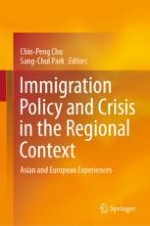2021 | OriginalPaper | Chapter
Migration Policy in Eastern Europe: The Case of Poland and Hungary
Author : Ewa Rokicka
Published in: Immigration Policy and Crisis in the Regional Context
Publisher: Springer Singapore
Activate our intelligent search to find suitable subject content or patents.
Select sections of text to find matching patents with Artificial Intelligence. powered by
Select sections of text to find additional relevant content using AI-assisted search. powered by
